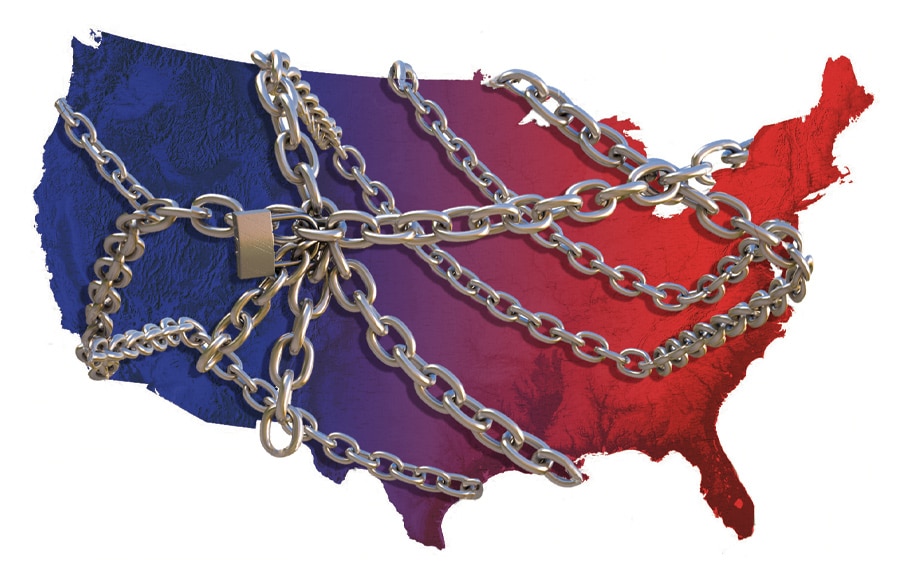
A Harvard white paper from the Safra Center for Ethics reminds us that the Italian word quarantine refers to 40 days.
The social distancing stay-at-home orders, the lockdown-in-place, and the enforced collective self-isolation must be reviewed frequently by public officials, and must be justified by ethical and practical considerations of their societal cost in order to maintain public approval and support.
U.S. deaths due to the COVID-19 infectious disease are not close to the originally predicted 1.5 million to 2.2 million by the famous Imperial College report (if we failed to mitigate the risk by social distancing).
The final count of lost souls, and the final mortality rate from the invisible enemy is still undetermined, but it is not likely to be much higher than many other infectious diseases.
It does appear however that COVID-19 is more contagious than prior viral epidemics, and as a new strain, it caught the world off-guard without defensive therapies and vaccines.
Those with preexisting conditions (co-morbidity) are sadly the most vulnerable. There are some reports of faulty death counts as cardio-deaths, for example, among victims carrying the virus, are reportedly all being labeled as COVID-19 deaths.
Annual influenza deaths in the USA have reached upwards of 80 thousand in a given year. Deaths from other diseases and from accidents like car crashes do not invoke the sentiment “if we can just save one life it’s all worth it.” If that were true, we would not have speed limits above 20 miles per hour.
Clearly, saving some lives by costing many more lives is not an ethical outcome.
Suicide rates, medical deaths from lack of health care services due to hospital prioritization of COVID-19 patients, depression, divorce, poverty, and spousal and child abuse are all skyrocketing. Prisoners are being prematurely let out of jail and innocent Americans are losing civil rights and liberties. The quality of life around the globe is declining dramatically.
We are witnessing the further rise of the surveillance state. Freedom is a victim, big time.
The economic cost of the shutdown of the global economy will be potentially long-lasting and possibly far more deleterious to human flourishing than advocates for mitigation have acknowledged.
The cost of the cure may prove to be far higher than the results of the awful disease. Government spending and extraordinary public debt has again been a feature of yet another crisis in which short-term considerations will cost future generations, likely quite significantly.
The major reason for the extreme government mandates was the appeal by the health care industry to flatten the curve and avoid overwhelming our hospitals, which were under-prepared for a surge in cases (ICU beds, ventilators, respirators, masks, protective equipment for health care workers, gowns, etc.).
Fortunately, we are witnessing many noble acts of extraordinary public service by healthcare workers, businesses, average citizens, and tireless public servants.
We root for surging medical capacity and potential drug therapies and bio-medical testing, patents, and production of effective vaccines.
There are 3 models suggested for moving forward as a society.
First, freeze in place. We simply sacrifice our economy to crush the virus. The social costs of this are unimaginably massive, and it isn’t clear the virus still won’t continue to spread.
As long as the food supply remains robust, we could likely survive this extended period of social isolation, but one cannot discount the risks of public rioting and looting.
Second, mobilize and transition. We fight the virus and open up the economy in stages, using best practices to reduce risk while practicing wise public healthcare measures.
The goal of this middle path is nothing less than avoiding the bankrupting of our nation and our citizens. Key features of this strategy include massive testing and contact tracing, and the isolation of vulnerable populations to reduce their risk exposure to the pathogen.
Third, we simply surrender to the virus, sadly accepting increased numbers of victims, and we move forward rapidly to recover our economy and societal progress.
We might still delay school re-openings until the fall, and require temperature taking to send sick kids home. But we all soldier on and try to save our GDP to avoid extreme poverty and its own foreseeable massive healthcare crises.
Policy makers will need to consider the following questions in organizing the path we will take:
1) What is the scientific clarity about the incubation period for the virus and what is the actual transmission path, such that we better understand containment & mitigation going forward ? Will we be wearing masks in public for months?
2) WIll the virus continue to infect masses of people, even during pandemic deceleration, as we re-open the economy ? What is the true reproduction rate, and case fatality rate, and will these numbers decline as more and more Americans become exposed and therefore potentially immune to a possible return of the virus in the fall or winter ?
3) Will we have enough on-demand testing to allow citizens with anti-bodies to re-enter the workforce and social living ? Can we leverage the plasma from those with anti-bodies to inoculate or assist others facing infection?
4) Will relatively inexpensive and available hydroxychloroquine or other medicines prove quickly effective in saving lives?
5) Will vaccines arrive in time to avoid an economic Depression?
6) Will corporate revenues and government funds to individuals allow businesses to survive in large numbers until earnings recover based on rising consumer confidence?
The federal and state governments and the banking system have so far responded with aggressive efforts at both medical and economic rescue. Lessons have been learned about China’s nefarious role and we will likely seek to bring our medical and manufacturing supply chain back to the USA.
At a minimum, we now face a new world of mask wearing, thermal scanners, and perhaps the end to the culture of handshakes.
Our policy makers have some serious decisions to make about what to do after our first 40 days of quarantine conclude.























 More news and opinions than at a Shabbat dinner, right in your inbox.
More news and opinions than at a Shabbat dinner, right in your inbox.